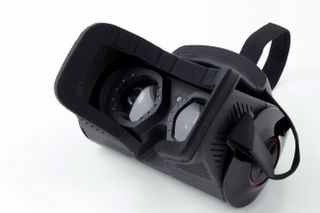Tobii's Poised For Big Wins In VR Eye Tracking (Update: A Qualcomm Partnership)
Update, 3/15/18, 12:15am PT: As we pontificated, Tobii has partnered with at least one major company--Qualcomm. Tobii announced that its eye tracking tech is coming to Qualcomm's Snapdragon 845 VR platform. The partnership will take form as a "full reference design and development kit." We also now have an official name for its eye tracking tech: EyeCore.
In a brief release, Tobii reiterated that its eye tracking tech enables foveated rendering, automatic interpupillary distance (IPD) image adjustment, hand-eye coordination harmony, and interactive eye contact. The company did not share any further details, such as a timeline or any pricing or other partner companies.

Original article, 1/23/18, 8:45am PT:
At CES 2018, Tobii showed us eye tracking inside a VR HMD that was as perfect an implementation as we’ve seen. That, coupled with the company’s unique position in the current market, places Tobii in a prime position for the market's future.
The Demo, Improved
We’ve been, er, tracking Tobii’s eye-tracking technology for quite some time, from gaming peripheral to integration with gaming laptops to research. Back at GDC 2017, we saw the company’s eye tracking embedded into an HTC Vive, and we were sufficiently impressed. At CES 2018, Tobii showed us much of the same demo on the same HMD (although there were a couple of extra scenarios thrown in), but we were stuck by how superb the eye tracking felt this time around.
Wondering if we were just imagining things, we pressed company representatives, and indeed, since GDC, they had tweaked the hardware a bit and had done a great deal of further development on the algorithm and the software. In other words, our eyes were not deceiving us: This demo was even better than the last one.
We’re not typically overly effusive with these subjective demos, and we’ve seen plenty of excellent eye tracking in VR, but none have exceeded what we saw in Tobii’s suite at CES. The interactions were as fluid and natural as they are in the real world. Hand/eye coordination was not just precise, but adjustable, such that a game developer could make a throwing game easier or more difficult as they saw fit.
Stay on the Cutting Edge
Join the experts who read Tom's Hardware for the inside track on enthusiast PC tech news — and have for over 25 years. We'll send breaking news and in-depth reviews of CPUs, GPUs, AI, maker hardware and more straight to your inbox.
The whole point of eye tracking is to make it invisible to your brain because of how closely it mimics how our eyes, hands, and brains coordinate in real life. Tobii has achieved that.
Most VR tracking on headsets actually tracks your head, not your eyes. But our eyes and heads can move independently from one another, especially when we’re performing actions such as looking at objects we want to pick up or navigating menu screens. In fact, our eyes typically lead the way, with our heads following after. (You can try this at home. Keep your eyes locked into one position, looking straight ahead, so they aren’t moving up or down or side-to-side. Now try and look at an object you want to pick up, moving only your head while keeping your eyes in a fixed position in your skull. See?)
In this demo, all of that was happening fast enough--and accurately enough--that we couldn’t perceive any of the “edges.” It was just there, working faster than our brains could observe it. It’s also worth noting that the setup for our demo took just a few seconds, so there was nothing special about our particular setup.

Standing Alone
Although this Tobii demo was as close to perfect as any eye-tracking implementation we’ve seen, many of the others certainly pass muster. But Tobii’s big advantage is that it remains independent. SMI was snapped up by Apple. EyeTribe is now owned by Oculus. Google bought Eyefluence.
There are other smaller eye tracking companies out there, including Fove and QiVARI, and one called AdHawk Systems just recently nabbed millions in funding from Intel. Tobii, though, is in a unique position. It’s still independent (and it’s going to stay that way); it’s not a plucky startup. It’s an international corporation with multiple departments and some 900 employees. That means it has plenty of R&D capability (indeed, its research and gaming arms can cross-pollinate), and it’s not looking to be acquired. The company’s goal is to license its tech to any HMD maker who wants to implement it.
Assuming that Oculus and Apple aren’t interested, seeing as how both have their own in-house eye-tracking IP now, that leaves some major players. HTC Vive would be a prime customer, but so would any of the headsets built on Qualcomm’s platforms. This is not to mention Windows Mixed Reality headsets, which would benefit a great deal from the eye tracking not just in gaming, but also in productivity. It’s also part of the OpenXR initiative, so it should be compatible with OSVR-based designs, too, and some of those are matriculating out past consumer VR and into installations and arcades.
In other words, Tobii’s plan is to go wide and rake in licensing revenue, and the market is wide open. Don’t be surprised to see its eye tracking technology show up in multiple XR headsets in the coming year or two.
Most Popular






